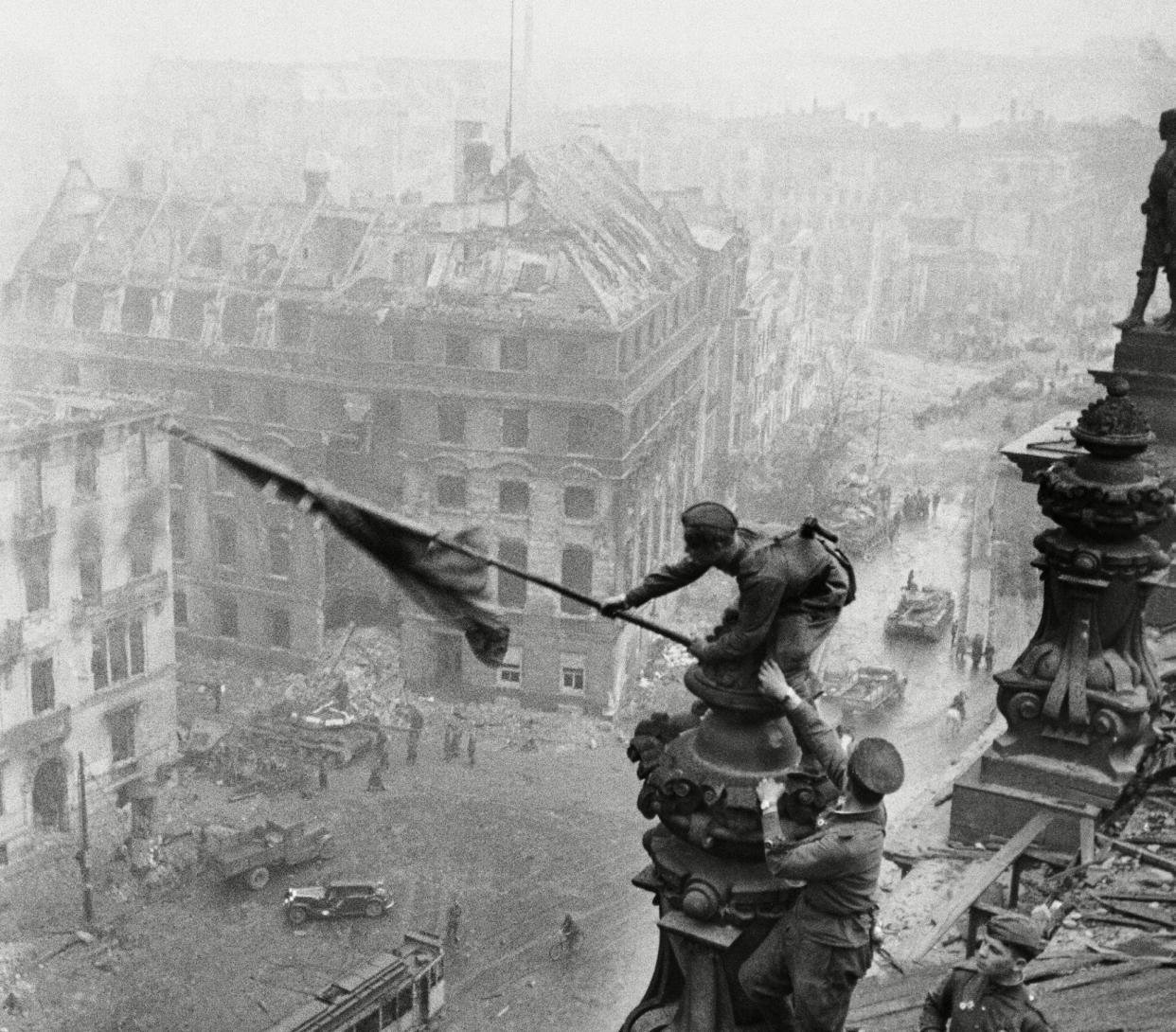A picture’s worth a thousand words … but only some of them tell the whole truth

A Russian soldier raises a Soviet flag over Berlin’s Reichstag in Yevgeny Khaldei’s well-known 1945 photograph of wartime triumph.
But in the original image, the officer standing below can clearly be seen wearing a watch on both wrists. Khaldei’s shot, first printed in a Moscow magazine, was quickly withdrawn and the extra watch, which might actually have been a military compass, was removed for safety’s sake. Looting was not a good look and was punishable by death.
This little-known work of deliberate visual distortion is shown in a new exhibition, The Camera Never Lies, which opens later this month and tackles the public’s dwindling faith in photographs. Tristan Lund, who co-curated the new show, said: “It’s rare to see both the ‘before’ and ‘after’ prints together. The Khaldei photograph that went out later had one watch scratched out because the editors knew this tiny detail might have incriminated not just the officer but the whole Soviet army.
“In the second image, the sky is much darker and dramatic as well. It has been massively manipulated for effect.”
The exhibition, which features more than 100 images from world-renowned photographers including Don McCullin, Stuart Franklin, Robert Capa and Dorothea Lange, will demonstrate that a picture, however well intended, can never be the whole story. Although few images on display involve deliberate distortions, the interpretations of several have spawned controversies and rival accounts.
The show, at the Sainsbury Centre in Norwich, features shots of the assassination of President Kennedy, the Chinese “tank man” protester in Tiananmen Square, and the chilling image of a figure jumping from New York’s burning World Trade Center in 2001. Running from 18 May until 20 October as part of the six-month series What is Truth?, it looks at how altered context, sometimes coupled with technical manipulation, has defined events in modern history.
The role of photographs as a reliable, trustworthy source is increasingly under threat, with editing technology now readily and cheaply available. In March, family shots put out by the Princess of Wales were found to have been edited, and the Observer revealed that other candid royal photos had been quietly altered before.
Lund said that he and his collaborator, Harriet Logan, still value the “inherent truth” of the work they display, although he believes it poses a key question for our age: “The exhibition asks what truths we can really expect to extract from a photograph. Is the succinct and objective sharing of facts the thing we remember most from a single image, or is it the emotion triggered by the composition and creativity of the photographer that tells a thousand words?”
Visitors will be able to compare three of the four images of Tiananmen Square that went into news archives. Franklin’s 1989 shot “The Tank Man” depicts a moment when the Chinese government cracked down on a lengthy Beijing democracy demonstration, killing hundreds on 4 June. The unknown protester who stood in front of a line of tanks was photographed from different angles by cameras inside the same building, documenting a scene that has been heavily censored in China but in the west has become an emblem of oppression.
“Younger people may not know where the picture came from and, if they do recognise it, they will probably have a composite of all the photographs in their mind,” said Lund. “One image zooms in on the protester while another is a little further out and includes the distraction of a street lamp. Franklin’s has more of the street and the tanks.
“We wanted to remove each from its news context to slow down the way people could look at them. We are displaying it with the Kate Adie BBC report from Tiananmen and with a work we’ve commissioned from a contemporary Chinese artist whose father was in the square. Some of his friends didn’t survive. She does not want her name known because she wants to continue to visit her family in China.”
“Beijing continues to deny that it happened,” added Logan, a former news photographer. “But for the public the image is often a proof, a kind of verbatim truth, that allows us to relax about what we are being told about uncomfortable events. Many of the images in the exhibition, like the one known as “Napalm Girl”, from Vietnam, have become part of history.”
This upsetting image of Phan Thi Kim Phuc, who was photographed as a young naked girl fleeing a napalm attack, now visually represents a 20-year war, Lund said. The same has happened with Capa’s 1936 photograph “The Falling Soldier” from the Spanish civil war. The story behind this shot is disputed, due to the lack of background detail given by Capa at the time and the loss of the negatives. Some suggest it was staged. Research later established the location and revealed that on that day the frontline was some distance away.
“Capa was only 21 when he took the [shot] and he will have sent back an unprocessed roll of film which may not have been correctly captioned. That happened,” said Logan. “I worked back in the analogue days, and picture editors cropped photographs later and made decisions that defined an image. So when Capa got home he will have been confronted with a whole lot of truths attributed to his image.”
Seventy-nine years later, another Magnum photographer, Max Pinckers, stood on the same hill with a colleague and made the artwork Controversy, now also in the show. Using a high-resolution camera they recorded the landscape, now empty except for olive trees.


